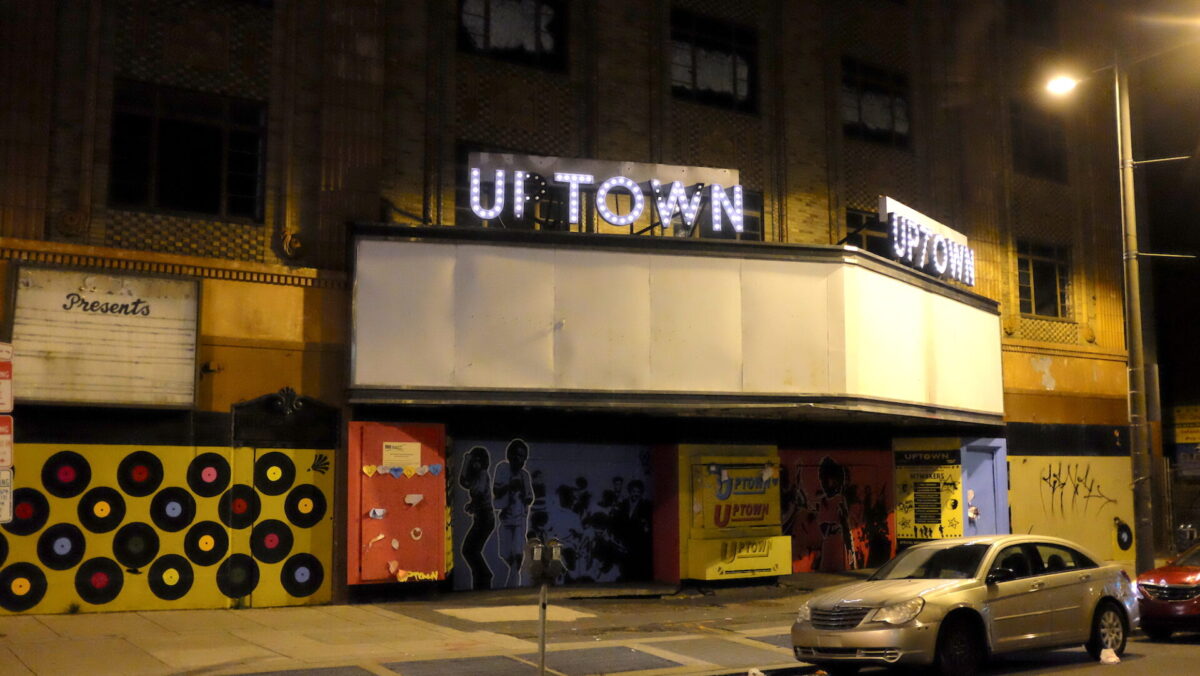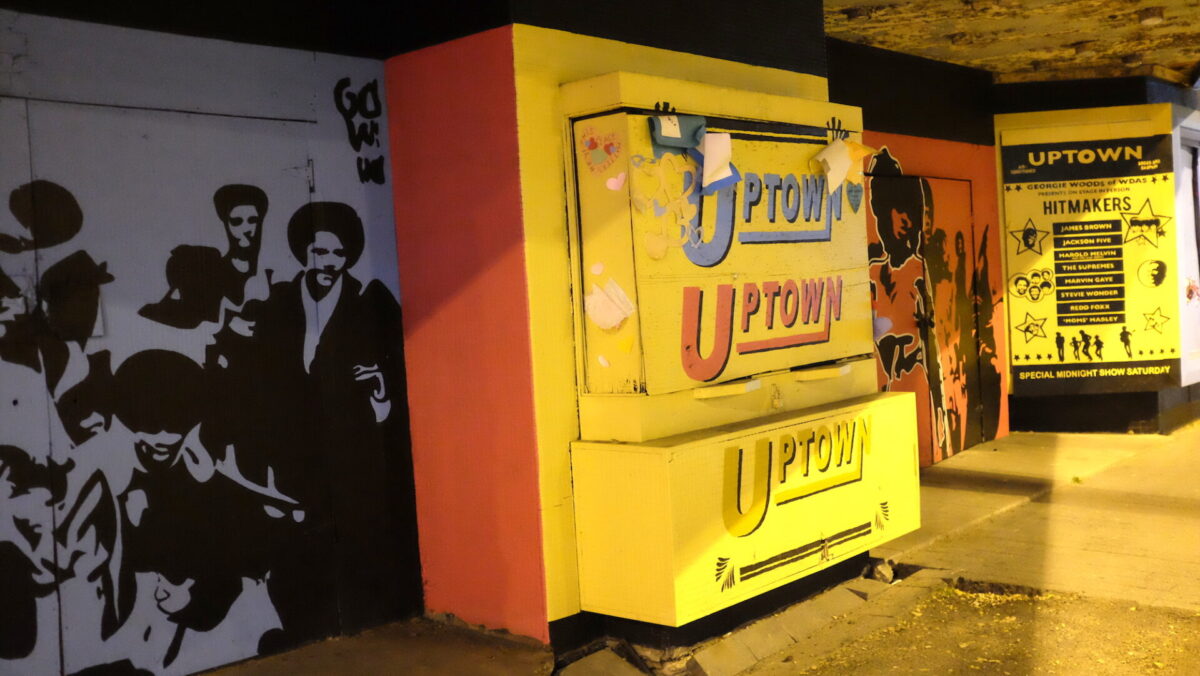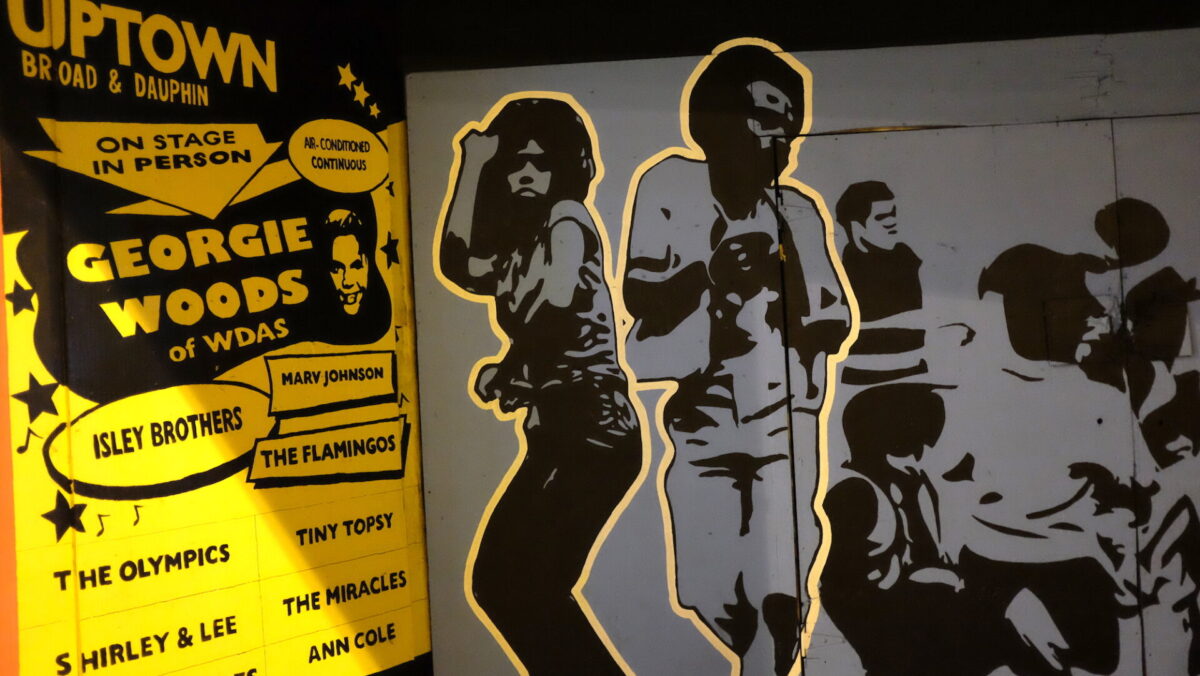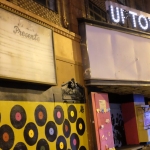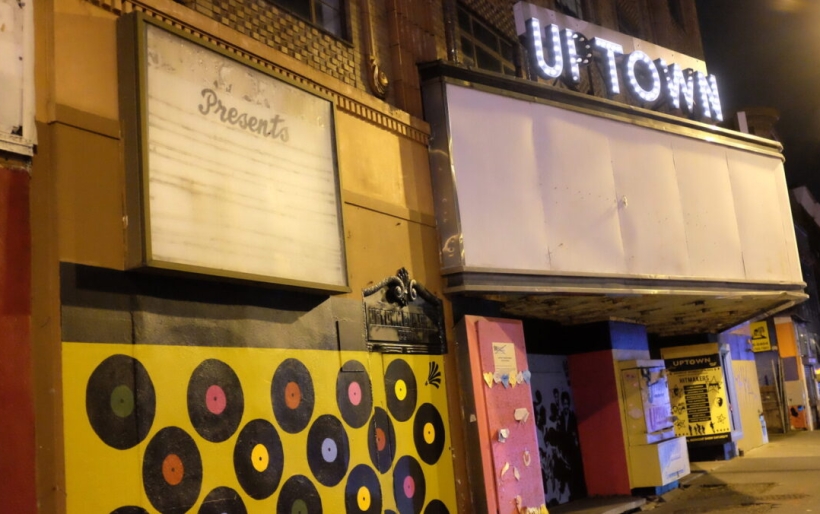
Uptown Theater | photo by John Vettese for WXPN
Uptown, Everything’s Alright: Philadelphia’s legendary home to live R&B is looking to make a comeback
Though born in the genteel era of the Great Depression, 2240 N Broad Street’s art deco Uptown Theater came to life and prominence in the latter 50s and through the 1970s as THE haven for raw R&B and sweet soul not named The Apollo.
Designed by architect Louis Magaziner as a metallic jewel box theater with a wide stage and stained glass amenities, and opened on February 16, 1929, the one-time movie and vaudeville palace became a valued commodity of the neighborhood’s then-growing African-American community under the ownership of Sam Steifel (he also owned Baltimore’s Royal and DC’s Howard Theaters), no to mention the management of Sid Booker, and the producing, promoting and booking of Georgie Woods from WDAS AM.
“Georgie was The Uptown,” said his longtime friend and fellow on-air jock / live show producer Jerry Blavatt. “If you were a great soul and R&B star — Smokey, Ray, James Brown, Sam Cooke, Stevie Wonder the Four Tops — you played The Uptown while the labels made the most of your time in Philly by getting you on every radio station and television show. And why not? That venue was like a palace. Gorgeous.”

Uptown Theater | photo by John Vettese for WXPN
Woods produced his last event at the Uptown in 1972. The theater stayed open until 1978. True Light Community Ministries purchased the Uptown in 1989, but abandoned the property after a 1991 storm damaged the roof, and for some time since, the soul palace sat as a dilapidated mess. That is until, The Uptown Entertainment and Development Corporation bought the building, and quickly moved through the process of renovating the offices above the stately auditorium, and now is in the business of restoring its stage and securing all necessary funding. That’s what brought us to North Broad on a cold and windy February night: to look at the copies of vintage Uptown events lining the theater, and to watch the large, newly restored marquee light up the sky in celebration of the building’s 90th anniversary — its glorious funky past — as well as its plans for its soulful future.
Linda Richardson, Founder of Uptown Entertainment and Development Corporation, was outside the Uptown as its marquee came alive for the first time since the 1970s. “That was really something to see and be part of,” said Richardson, weeks after the lighting. “That was the first of many such events for the new Uptown.”
Born in West Philly, Richardson may not have attended and hung out at the Uptown. But like any great researcher, she has collected countless memories of living in the North Philadelphia community surrounding the theater, dancing and vibing inside the soul palace, or those whose lives were touched by the venue — from Patti Labelle to Miss Kaye, who raised her family right behind the Uptown. “I’ve talked to so many people who saw James Brown, the Intruders, the O’Jays, and various Motown revues at The Uptown,” said Richardson. “There were matinees during the day, and midnight shows that tended to be more risqué, and what I heard was that young people would hide under the seats or in the rest rooms so that they could stay for all the shows up through the after-hours events. I also have tons of neighbor stories about waiting by the back stage door on Carlisle Street and meeting many of the performers who, on their break, would either have a smoke or get dinner at Miss Pearl’s house who lived on the block.”

Uptown Theater | photo by John Vettese for WXPN
Blavatt’s photographic recall of The Uptown includes the fact that before Steifal, it was the Milgram family (of local movie theater chain fame) that owned the Uptown and brought its first stage shows to its stages. “Before the Uptown, there was the Pearl, the Earle and the Royal where Sinatra and the Dorseys played, “ said The Geator. “As rock n’ roll and R&B began to become prominent, a stage was needed for that too. That’s where Georgie (Woods) came in. He was the guy.”
Blavatt goes onto remember everything from the Uptown’s first white act, The Magnificent Men (“’Peace of Mind’ was theirs, Georgie heard me playing them, put it on and a had great response. He tells me he has to have the, until I mention they’re white. So he brings them, on but has ME introduce them”), all the way to his take on what killed the Uptown. “The casinos,” said Blavatt. “That’s when those acts began getting big money. When Smokey or The Tempations worked the Uptown, the record companies would call Georgie because he was banging their records in the early days. The labels would fly the bands in, as they needed the exposure. Everyone was paying peanuts for some of the greatest acts that ever existed. That stopped when the casinos came into vogue. The Uptown couldn’t afford their prices.”
Richardson’s Uptown Entertainment and Development Corporation was not her first civil advocacy charge. She had the first project on the Avenue of the Arts to be completed, 1996’s renovation of five townhouses that became the offices for cultural organizations such as Jill Scott’s Blues Babe Foundation, right across the street. “Becoming an owner, then a stakeholder, gave each purchase meaning,” she added. When she heard about the plight of the Uptown in 1995, she sent her contractors, researched ownership and feasibility, and, eventually created the UEDC non-profit so to buy and begin renovating the theater. Richardson and her small staff learned preservation techniques from the several historical registries that the Uptown were awarded with, as the Uptown is “historic because of its architect as well as how it represented the R&B scene and African- American lifestyle of the 1960s and 70s”… along with it being “the only remaining Art Deco movie theater in the city.”

Uptown Theater | photo by John Vettese for WXPN
Richardson says the budget for physical renovation is around $10 million, $5 million of which has been so far raised. Sixty percent of Uptown’s infrastructure has been worked on, and fixed, with UEDC’s next goal of finding a partner who can complete this project. “Our first projects were windows which we had replaced. Then the terracotta tile which is part of the façade, that was fixed by a Germantown artisan. Then the marquee, which is now lit from 5 p.m. until 5 a.m. every day.” The goal is to break ground on additional renovations in the autumn of 2019.
What must be renovated and restored is one thing. There is the music, too, old and tied to Philadelphia’s Africa-American population (and beyond, as Hall & Oates in their individual, varied street corner soul vocal acts, played there during their tenure at Temple University). Past the notions of physical preservation, the UEDC began looking for partners in the local entertainment booking industry to match her enthusiasm, someone who can bring new life to Uptown’s vintage stage. Richardson’s preference is to bring in young, independent promoters, producers and bookers to perform in the venue as, “in its past, the Uptown created opportunities for adventurous entrepreneurs to make their careers,” she said. “Our goal for 21st Century entertainment is much the same as it was in the 1960s, moving toward providing untrained talent a new opportunity with new technologies.”
That said, Richardson would not eschew the advances of Live Nation or AEG/Bowery Presents, and nothing is off the table when it comes to booking the Uptown, a palace whose opening night she would love to see shared with The O’Jays and several of Harold Melvin’s Blue Notes. “We love what (Eric Blumenfeld and Live Nation) did with The Met, and that the building’s owner, Reverend Hatcher, could find ways of having that venue thrive again. His programs and ideas have gone unheralded for over 20 years, so it is great seeing them come to light. We’d like to be part of the North Broad renaissance, to be an anchor of arts and entertainment just a little further up north than them.”
- Uptown Theater | photo by John Vettese for WXPN
- Uptown Theater | photo by John Vettese for WXPN
- Uptown Theater | photo by John Vettese for WXPN
- Uptown Theater | photo by John Vettese for WXPN
- Uptown Theater | photo by John Vettese for WXPN

